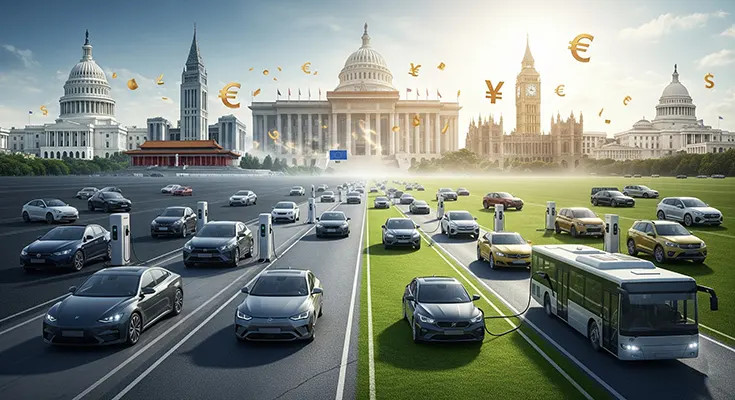The global surge in electric vehicle (EV) adoption is not a spontaneous market phenomenon. While technological advancements and consumer interest are crucial, the relentless push for cleaner transportation is a direct result of comprehensive and multifaceted government policies and incentives. Governments worldwide are acting as a powerful catalyst, addressing key barriers to EV ownership and creating an environment where a fossil-fuel-free future is not just a possibility, but an inevitability.
These policies can be broadly categorized into three key areas: fiscal incentives, regulatory frameworks, and infrastructure investment.
1. Fiscal Incentives: Reducing the Sticker Shock
The high upfront cost of EVs compared to their internal combustion engine (ICE) counterparts has historically been the biggest hurdle for consumers. Governments have used a combination of financial incentives to bridge this gap and make EVs a more economically viable choice.
- Purchase Subsidies and Tax Credits: This is the most direct and widely used policy. Countries like France, Germany, and the United States have offered significant financial rebates or tax credits for new EV purchases. For instance, the U.S. Inflation Reduction Act (IRA) provides a tax credit of up to $7,500 for eligible new clean vehicles, with specific requirements on domestic manufacturing and battery component sourcing. China, a global leader in EV adoption, has also heavily relied on subsidies, although it has begun to phase them out as its domestic market matures.
- Tax Exemptions and Reductions: Many countries offer long-term financial benefits to EV owners. This can include exemptions from sales tax, registration fees, or annual road tax. Norway, a pioneer in EV adoption, has successfully used a combination of purchase tax exemptions and reduced road tax since the 1990s to make EVs cheaper to own and operate than gasoline cars, a policy that has led to an overwhelming EV market share.
- Trade-in and Scrappage Schemes: To accelerate the removal of older, more polluting vehicles from the road, governments are offering incentives for trading in an old ICE car for a new EV. China has implemented a highly successful trade-in scheme that offers a greater subsidy for swapping to an EV than to a new ICE vehicle, further encouraging the transition.
2. Regulatory Frameworks: Setting the Rules of the Road
Beyond financial carrots, governments are also using regulatory sticks to drive change. These policies create a clear and predictable pathway for the industry and force a shift towards zero-emission technologies.
- Emissions Standards and Sales Mandates: The most impactful policies are those that directly regulate automakers. The European Union’s stringent CO₂ emission targets for vehicle fleets effectively compel manufacturers to sell a certain number of EVs to avoid hefty fines. Similarly, the Zero-Emission Vehicle (ZEV) mandates in places like California and several other U.S. states require a growing percentage of new vehicle sales to be ZEVs.
- Access and Mobility Policies: Cities and regions are increasingly using non-financial incentives to reward EV ownership. These can include exemptions from traffic restrictions in low-emission zones, free or discounted parking, and even access to dedicated bus and carpool lanes. These benefits add a layer of practical convenience that can sway consumer decisions, as seen in major Chinese cities and in countries like Norway.
3. Infrastructure Investment: Building the Backbone
The best EV in the world is useless without a place to charge it. Governments are recognizing this and are making massive investments in charging infrastructure to combat “range anxiety” and ensure convenience.
- Public Charging Networks: National and regional programs are funding the deployment of publicly accessible charging stations, particularly DC fast chargers along major highways. The U.S. NEVI program, for example, is allocating billions to build a national charging network. This public investment helps de-risk the market and encourages private companies to build out their own networks.
- Residential and Workplace Support: Incentives are also being provided for home and business charging infrastructure. Tax credits and rebates for installing residential Level 2 chargers make at-home charging more accessible, which is where the majority of EV charging happens.
- Standardization: Governments and international bodies are working to standardize charging protocols and payment systems. This ensures interoperability between different charging networks and vehicle brands, making the user experience seamless and hassle-free.
Government policies are not just a temporary boost for the EV market; they are a fundamental force of change. By addressing the core challenges of cost, convenience, and infrastructure, these policies are building the foundation for a sustainable transport system. While the specific incentives may evolve—as seen with the phasing out of some direct subsidies in mature markets—the long-term commitment to a zero-emission future through a combination of fiscal, regulatory, and infrastructural support remains the driving force behind the global electric revolution.

